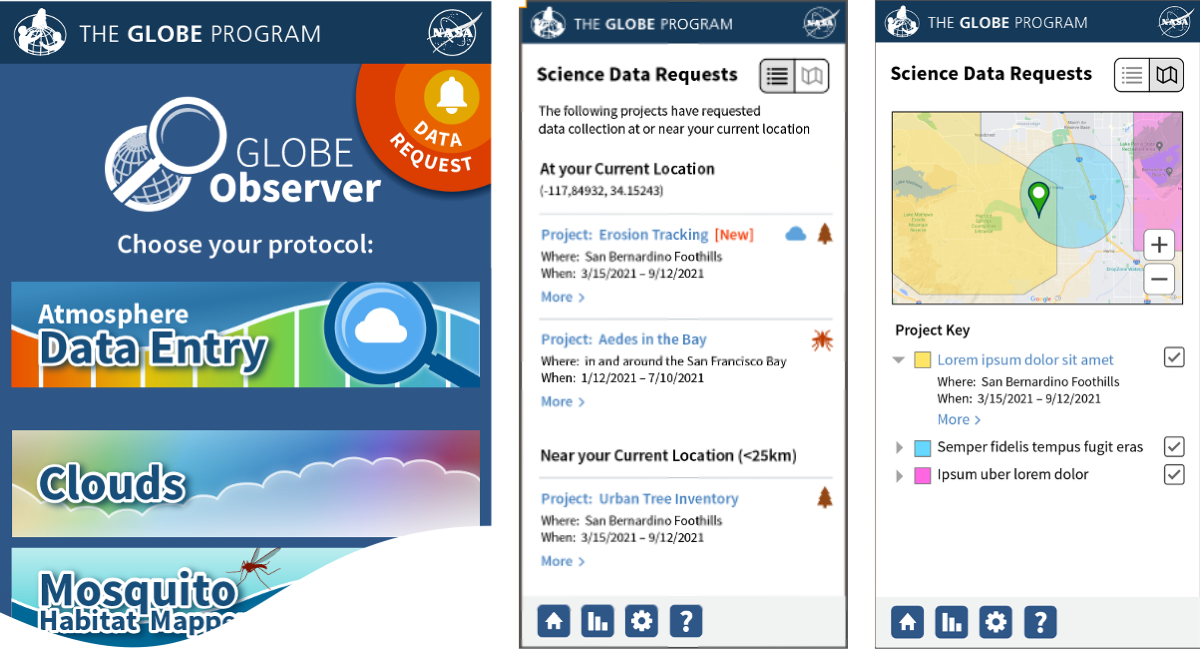Request Observations - GLOBE Observer
Requesting Data Collection in the GLOBE Observer App
The GLOBE Observer app includes a mechanism (a geofence) that alerts volunteers when they open the app that clouds, mosquito habitat, land cover, trees, or eclipse data are needed at or near their location. Each data request provides specific instructions for data collection as well as information about the research or community project the data will support.

Volunteers see an alert on the GLOBE Observer home screen if there is a data request at or near their location. Clicking on the data request icon leads to a list or map of requests. (The map is only available if the device is online.)
Applying for a Data Request
Scientists, educators, or community leaders who have GLOBE accounts (GLOBE Observer or GLOBE member accounts) may submit an application through the GLOBE Observer website to create a data request. Note: Currently requests can only be made for the United States. Each data request or geofence proposal must include a point of contact available to answer volunteer questions, justification for why the data collection is needed, and what the project aims to accomplish. Requests may include special instructions or links to additional training for volunteers. We recommend that each data request is linked to a GLOBE Team to give the project leader a way to track data submitted and to communicate with volunteers working on their project. Data requests should cover a time period no longer than three months but may be renewed if a longer period is needed.
Each project leader must certify that the data request does not fall in sensitive areas such as private or native lands or sensitive ecological regions, or in unsafe or inaccessible areas. If the request does cover such areas, the project leader will need to provide permission for data collection from landowners or managers and/or sufficient warnings to volunteers (e.g. stay on paved roads or do not collect data outside of the defined region).
Data collected as a result of the data request will be stored in the GLOBE database where it will be openly accessible following NASA’s open data policy 
All information submitted through the application will be integrated into a project page for each data request, which is visible through the GLOBE Observer app and on the GLOBE Observer website. Project leaders may also link to project pages hosted outside of The GLOBE Program to provide additional information to volunteers.
Defining the Data Collection Area
The application will also define the region of interest. This may be done by submitting a GeoJSON file or by drawing the region of interest on a map. More information about defining a region of interest with GeoJSON is available.
Geofenced data requests may include a single or multiple geographic regions, but should be limited to a regional scale (i.e., not a full continent). Larger scale requests are better served by GLOBE campaigns.
As noted above, the data request should not cover sensitive or private land without permission from the landowner or manager.
Application Review Process
Once the project leader submits the request, The GLOBE Program will review the application for completeness and scientific validity (if the outcome is scientific). The application review process is anticipated to take up to a month.
Archived Requests
Once the data collection period ends, the data request will be removed from the GLOBE Observer app. The GLOBE Program and the project leader will coordinate to pull and archive data collected for the project. The data and any other products or outcomes will be posted on the project landing page on the GLOBE Observer website as an archive of the project.
Sample Requests
Example 1: A scientist asks volunteers to routinely submit observations of mosquito habitats in Oklahoma City and Norman, Oklahoma, through the months of June, July, and August to determine when mosquitoes are breeding (when the most larvae are present) and if harmful invasive species are moving into the metro region. Several habitat sites are identified throughout the two cities and volunteers are asked to report on mosquito activity at the sites throughout the summer. The outcome of this project is anticipated to be a scientific publication that could support a mosquito control plan.
Example 2: A Girl Scout Council in Portland, Oregon is participating in the Girl Scout Tree Promise, which aims to plant, protect, and honor five million trees by 2026. They ask volunteers to support Girl Scout troops by measuring every tree in the city and the land cover around it using GLOBE Observer during the months of October and April. Their primary objective is to create awareness and provide data to Girl Scouts to support their educational experience.









